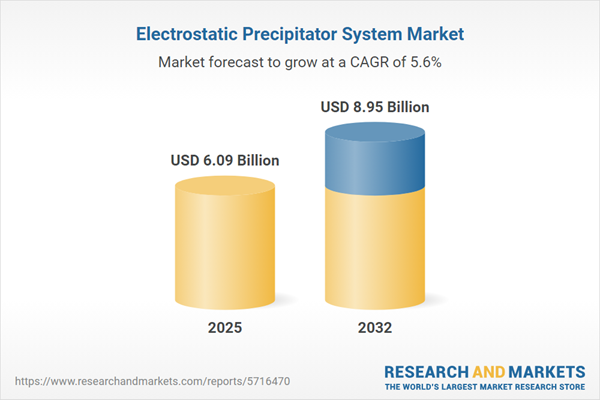Speak directly to the analyst to clarify any post sales queries you may have.
The electrostatic precipitator system market is undergoing rapid transformation, driven by stricter environmental mandates and digital innovation. Senior executives must recalibrate strategies to ensure organizational adaptability, operational efficiency, and continual compliance as the regulatory and technology landscape evolves.
Market Snapshot: Electrostatic Precipitator System Market Growth
The electrostatic precipitator system market reached USD 5.77 billion in 2024, grew to USD 6.09 billion in 2025, and is set to attain USD 8.95 billion by 2032, reflecting a compound annual growth rate (CAGR) of 5.62%. This trajectory is propelled by regulatory shifts, growing air-quality awareness, and recent progress in emission control technologies. Organizations across industrial sectors are investing in advanced and retrofit solutions to align with evolving compliance requirements. Digital transformation is increasing the need for systems capable of adaptive performance, helping companies meet changing benchmarks and streamline operations efficiently.
Scope & Segmentation
This report clarifies the full context of the electrostatic precipitator system market, ensuring senior executives have a strategic view across critical market dimensions:
- End-User Industry: Cement, chemical, mining, power generation, pulp and paper, and steel sectors include facilities seeking tailored emission control mechanisms and solutions to satisfy varied regulatory requirements.
- Technology Type: Plate, pulse jet, tubular, and wet systems provide distinct filtration capabilities suited to different particulate characteristics and downstream application priorities.
- Gas Type: Addresses specific contaminants and operational objectives by segmenting applications into flue gas, industrial gas, and mining gas treatment.
- Electrode Material: Criteria consider carbon steel, stainless steel, and titanium to compare longevity, energy use, and system economics across settings.
- Power Rating: Categorization below 50 kW, 50–200 kW, and above 200 kW supports configuration planning for both standard and specialized plant requirements.
- Phase: Single-phase and three-phase designs enable adaptation to a range of industrial electrical systems and integration scenarios.
- Duct Orientation: Horizontal and vertical configurations support optimal placement to match facility layouts, ensuring efficient air handling and space management.
- Regions: Market coverage spans Americas, Europe, Middle East, Africa, and Asia-Pacific, capturing the implications of different regulatory frameworks and adoption maturity across global regions.
- Key Companies: Major suppliers include Mitsubishi Hitachi Power Systems, Babcock & Wilcox Enterprises, Thermax Limited, Alstom SA, Hamon & Cie, Dongfang Electric, FLSmidth & Co., Doosan Heavy Industries, IHI Corporation, and Bharat Heavy Electricals, reflecting diverse competitive strategies and geographic presence.
Key Takeaways: Strategic Insights for Senior Decision-Makers
- Electrostatic precipitator systems enable plants to pursue sustainability targets while responding to progressively stringent compliance frameworks throughout the industrial sector.
- Integration of advanced digital controls and updated power architectures promotes reduced unplanned downtime, optimized maintenance, and enhanced return on capital through lifecycle cost control.
- Systems engineered with flexible architecture support seamless integration with automation platforms, allowing organizations to scale capacity and adapt to regulatory or production shifts.
- Adoption rates and system configurations are influenced by regulatory definitions, infrastructure capabilities, and investment climates unique to each global market.
- Organizational focus is expanding toward proactive lifecycle management, predictability in operational budgeting, and minimizing capital exposure throughout project lifespans.
Tariff Impact: Supply Chain Resilience and Sourcing Strategies
Recent U.S. import tariffs have led to increased costs for key input materials required in electrostatic precipitator system manufacturing, including high-grade steels and specialized electronics. To address supply chain uncertainties and price volatility, manufacturers are diversifying sourcing methods by strengthening local supplier networks, exploring nearshoring options, and establishing resilient partnerships. These strategies ensure business continuity for both system upgrades and new installations by safeguarding access to primary components, supporting project delivery timelines in a dynamic market environment.
Methodology & Data Sources
This report utilizes a methodical research approach, combining targeted executive interviews, secondary research from reputable industry publications, and rigorous data triangulation. Stakeholder engagement and internal review processes are used to affirm that all findings align with current market realities and meet executive planning requirements.
Why This Report Matters
- Empowers senior leaders to make informed decisions regarding compliance strategy, capital deployment, and risk mitigation in a tightly regulated market space.
- Equips procurement teams and plant managers with actionable guidance for aligning product selection and supplier relationships with emerging emission standards and local market expectations.
- Offers relevant intelligence that supports confident, timely decisions and adaptive strategic planning amid persistent regulatory and technological changes.
Conclusion
Access to current, actionable market intelligence is vital for organizations aiming to maintain compliance, drive operational efficiencies, and achieve sustainability objectives in the evolving electrostatic precipitator system market.
Additional Product Information:
- Purchase of this report includes 1 year online access with quarterly updates.
- This report can be updated on request. Please contact our Customer Experience team using the Ask a Question widget on our website.
Table of Contents
3. Executive Summary
4. Market Overview
7. Cumulative Impact of Artificial Intelligence 2025
List of Figures
Samples

LOADING...
Companies Mentioned
The key companies profiled in this Electrostatic Precipitator System market report include:- Mitsubishi Hitachi Power Systems, Ltd.
- Babcock & Wilcox Enterprises, Inc.
- Thermax Limited
- Alstom SA
- Hamon & Cie, S.A.
- Dongfang Electric Corporation
- FLSmidth & Co. A/S
- Doosan Heavy Industries & Construction Co., Ltd.
- IHI Corporation
- Bharat Heavy Electricals Limited
Table Information
| Report Attribute | Details |
|---|---|
| No. of Pages | 188 |
| Published | October 2025 |
| Forecast Period | 2025 - 2032 |
| Estimated Market Value ( USD | $ 6.09 Billion |
| Forecasted Market Value ( USD | $ 8.95 Billion |
| Compound Annual Growth Rate | 5.6% |
| Regions Covered | Global |
| No. of Companies Mentioned | 11 |









